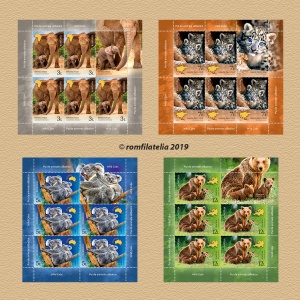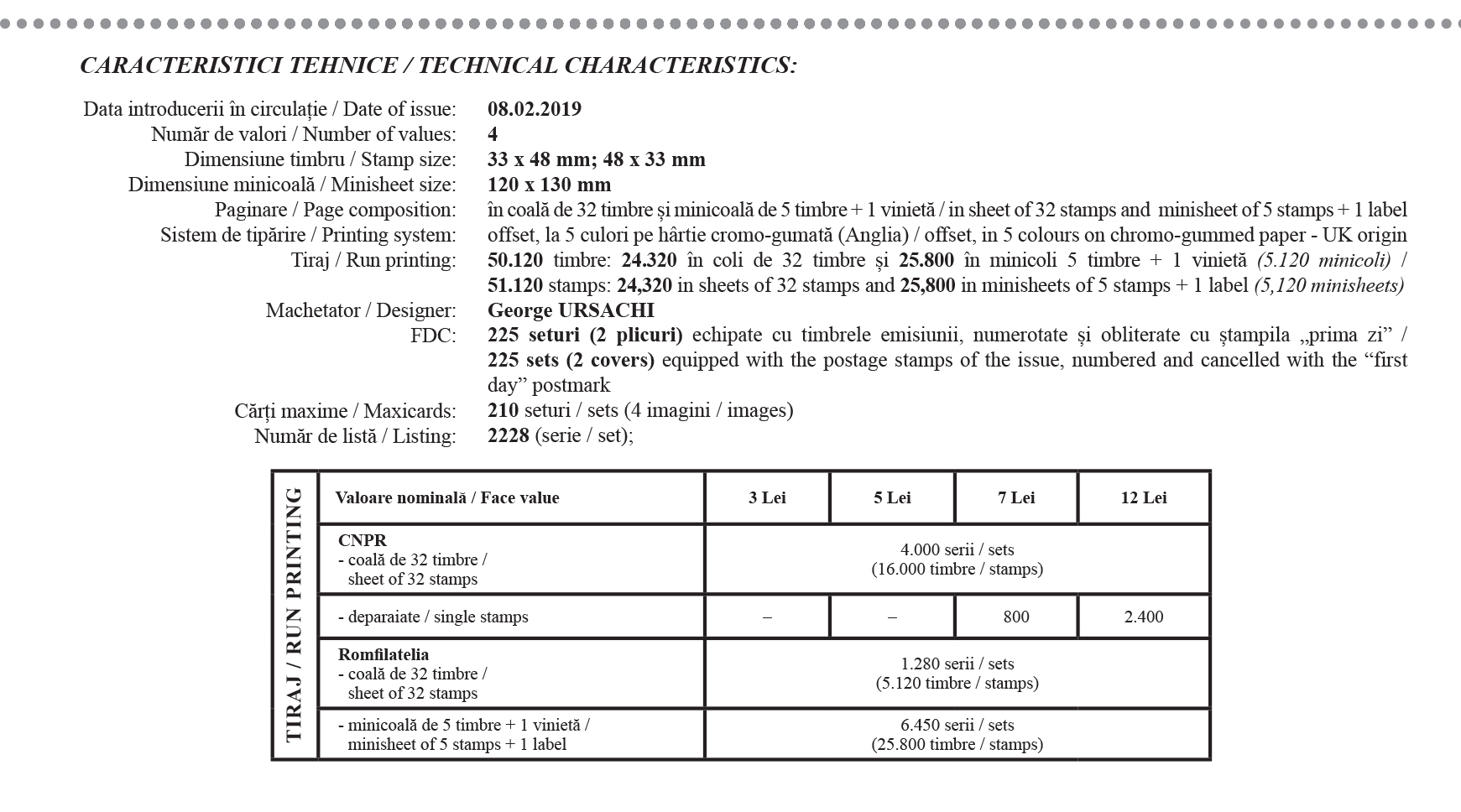 Continuing the highly appreciated theme of the fauna, Romfilatelia puts into circulation on Friday, February 8th of the current year, a new issue of postage stamps „Wild cubs”.
Continuing the highly appreciated theme of the fauna, Romfilatelia puts into circulation on Friday, February 8th of the current year, a new issue of postage stamps „Wild cubs”.
The cuddling of the baby animals awakens in our souls’ feelings of affection, and the babies of wild animals are a continuous attraction, as well as the environment in which they live, hardly known.
On the first stamp, with the face value of Lei 3, is illustrated the baby African elephant (Loxodonta africana), along with its mother.
The African elephant lives in sub-Saharan Africa, in deserts, forests, river valleys, swamps and savannas. The elephants live in cards of different sizes, made up of both sexes, cards that are most often led by a female.
The gestation lasts 22 months, the weight of the new-born baby elephant is around 100 Kg, and its height is close to 1 m. In the first two years the baby elephant is breastfed, but, in the meantime, it learns to use its trumpet and chew herbs and bushes.
The male baby elephants reached the threshold of maturity are expelled from the flock, not to mate with family members, female baby elephants remaining with the flock throughout their lives, and until the first delivery they help to grow younger babies.
On the second stamp with a face value of Lei 5 is illustrated the baby Koala (Phascolarctos cinereus), carried on the back of its mother during the climbing of a eucalyptus tree.
Koala is an arboreal marsupial herbivore endemic mammal living in Southern and Eastern Australia.
Spending practically its entire life in trees, koala sleeps 18 hours a day and feeds at night, preferring the leaves of twelve species of eucalyptus. It spends about three of the five hours of activity eating, consuming about 1.5 kg of leaves, which its choose carefully, as the young leaves of some eucalyptus species, at least during certain periods, synthesize, among others, Prussian acid, a poison extremely strong.
The female gives birth to a baby, which it carried backwards. Mating takes place between December and March when it is the summer season in the Southern hemisphere.
Koala babies at birth are hairless, blind and deaf. They stay in the marsupium for about 6 months, feeding on milk only. Then they go out of the marsupium and spend the next six months on their mother’s back continuing to drink milk, but in progressively smaller quantities, opening up their appetite for the eucalyptus leaves. Females quickly part company with the koala mother, the males remaining nearby for 2-3 years.
On the third stamp with the face value of Lei 7 is illustrated the Snow Leopard or the Irbis (Panthera uncia)
Also called the ʺGhost of the Mountainsʺ, the snow leopard is a solitary animal, of the feline family, which lives in the Central Asian Mountains and is on the verge of extinction. It lives only above the limit of Asian forests, in the summer it is withdrawn at altitudes of 3,600-4,000 m and in winter it descends to 1,800 m.
It is smaller than most big felines and can reach 55 kg. Its tail, almost as long as the body, helps it keep its balance when passing through steep cliffs. Elbows are wide and adapted to walking in the snow.
It feeds on gazelles, deer, goats, sheep, mountain cocks, rabbits, mice. The female is about 30% smaller than males and can give birth to 2-3 cubs on an average. Reproduction occurs at the end of winter, and gestation lasts 93 days, baby animals found born in May-June.
Up to the age of two, they live with their mothers who teach them to hunt and do for themselves in the wildlife. Their life expectancy is between 15 and 18 years.
On the fourth stamp, with the face value of Lei 12, are illustrated two Brown bear cubs (Ursus arctos) alongside their mother. The brown bear is met in Europe and is also present in our country.
It has the power to adapt to different habitats, from the plain to the forests and subalpine areas. It prefers wooded mountain areas, hard to reach, with fallen trees or cliffs, but also hilly areas, rich in orchards with fruit trees.
Pairing occurs between April and June, the gestation period is 7-8 months, the she-bear giving birth January through February to a number of 1 to 3 cubs, fed on the mother’s milk.
They are born blind, their sight coming after 25-30 days. The cubs sit beside the she-bear up to the age of 2-3 years. A bear family is formed only from the she-bear and her cubs, the male bear always living isolated.
On the two first day envelopes is illustrated the baby Fallow Deer (Dama dama), along with its mother.
Romfilatelia thanks the “Grigore Antipa” National Museum of Natural History for the documentary support granted for the achievement
of this postage stamp issue.



